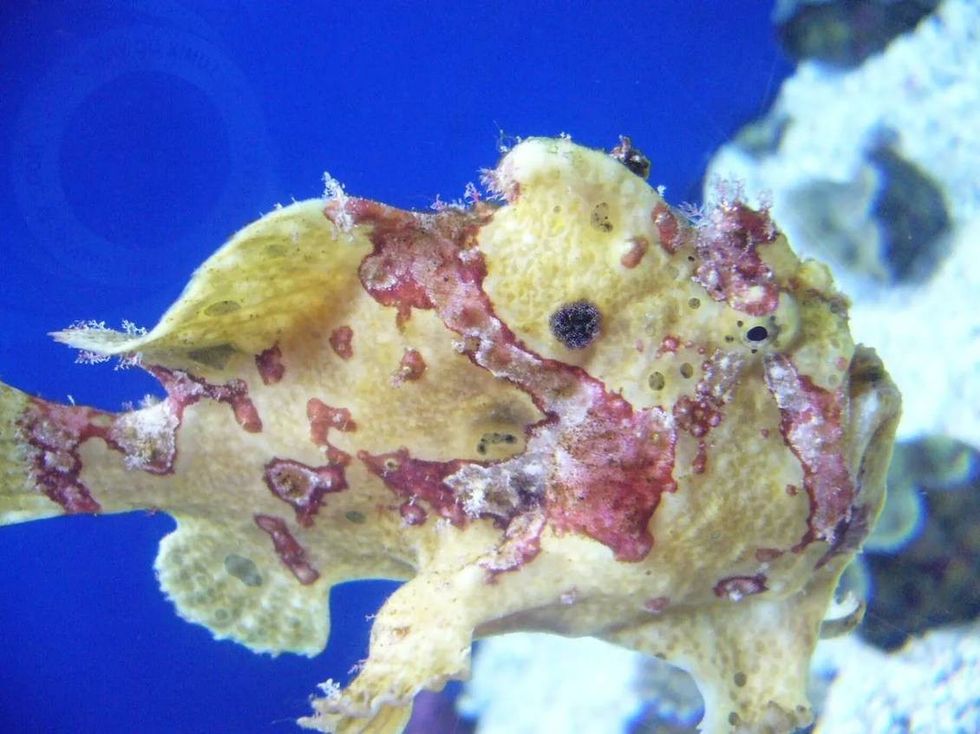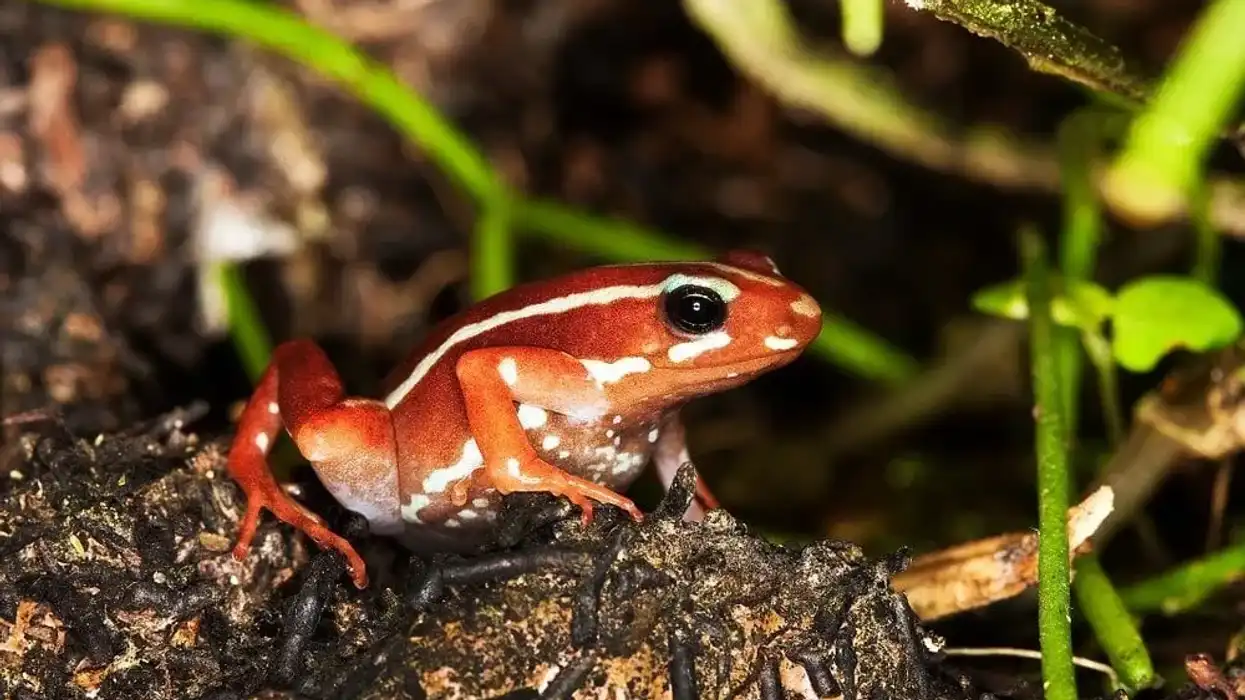Warty frogfish are marine benthic ambush predators that are very colorful. But they are also famous for camouflaging by changing their colors. Yes, they change their skin color, it's a defense mechanism. This helps them to let their prey come nearer as they are not very good at swimming.
Look at the adaptations of this fish. The first modified dorsal fin spine, the illicium, looks like a lure and is also used as a lure for prey. The modified pectoral spine fins look like limbs that help in their locomotion on the sea beds and between corals. The round gill openings behind their pectoral fins help in buoyancy.
There are so many names for this warty frogfish. Let's list them: Clown anglerfish, Wartskin angler, Galloping clown frogfish, Wartskin frogfish, Large-spotted angler, Wartskin anglerfish, Wartface frogfish, Wartface anglerfish, warty anglerfish, clown frogfish.
This article gives you an insight into the interesting lives of frogfish. If you like reading these facts, check out these codfish facts and milkfish facts for more.
Warty Frogfish Interesting Facts
What type of animal is a warty frogfish?
The warty frogfish (Antennarius maculatus) is a marine water frogfish. It is also known as the clown frogfish. There are many species of frogfish in the world.
What class of animal does a warty frogfish belong to?
Warty frogfish (Antennarius maculatus) belong to the Actinopterygii class. They are members of the Antennariidae family.
How many warty frogfish are there in the world?
The exact data about this marine water fish population is not available.
Where does a warty frogfish live?
Warty frogfish (Antennarius maculatus) are found in the waters of the Indian Ocean and the Pacific Ocean. They are found near Mauritius and Reunion Islands. The dive sites of these fishes are famous.
What is a warty frogfish's habitat?
They take shelter in rocky coral reefs in the oceans. Warty frogfish prefer Indo-Pacific tropical marine water. Most of the adult species are associated with the sponges at a depth of about twenty meters.
Who do warty frogfish live with?
Warty frogfish may spend their time alone. But during the breeding season, the pair sticks together.
How long does a warty frogfish live?
There is no data available on the lifespan of this marine water warty frogfish. But in general, frogfishes live up to five years in the wild.
How do they reproduce?
The females spawn 40,000-180,000 eggs, and they spawn several times over a few weeks. Their eggs float together in a mass of gelatinous mucus-like substance known as egg raft and veil.
Once the embryos hatch they sink to the bottom and stay there during this planktonic stage for around two months. After that, young larvae with considerably larger heads will start their lives on their own without any parental care.
What is their conservation status?
According to the IUCN Red List, the conservation status of the marine water Warty frogfish (A. maculatus) is Not Evaluated.
Warty Frogfish Fun Facts
What do warty frogfish look like?

The Warty frogfish (Antennarius maculatus) has wart-like projections or small dermal spinules on its soft skin, hence its name. Their body appears globular.
The Wartface anglerfish has a larger mouth. The first modified dorsal fin spine, the illicium, looks like a lure and is also used as a lure to prey.
The modified pectoral spine fins look like limbs that help in their locomotion on the sea beds and between corals. The round gill openings behind their pectoral fins help in the buoyancy in the absence of a swim bladder. Hence are called galloping clown frogfish.
Interestingly, Wartskin anglerfish are masters in the art of changing color to camouflage into their surroundings. Wartface frogfish come in multiple yellow, orange, white, and red colors.
How cute are they?
The warty frogfish (A. maculatus) are fishes that lure another fish with a fish. These creatures lure their prey nearer before gulping them whole with their big mouths. Sometimes it is difficult to locate this marine water clown frogfish in their surroundings as they change their colors and camouflage.
How do they communicate?
Not much information is available regarding the communication of this fish species of wartskin anglerfish but their bio-fluorescence characteristic (re-emitting ultraviolet light as red) is believed to be an essential part of their communication. Unfortunately, they are solitary creatures and don't communicate much with other frogfishes in their surroundings.
How big is a warty frogfish?
Adult warty fish may grow up to six 5.9 in (15 cm) in length with fins modified into a lure. But, like any other frogfish, even a warty frogfish has an extensible body and a very big mouth.
How fast can a warty frogfish swim?
Warty frogfish do not swim very fast, and their speed is not available. The creatures crawl around and perch on the coral reef. The modified pectoral fins look like limbs that help in their locomotion.
In addition, the round gill openings behind their pectoral fins help in the buoyancy in the absence of a swim bladder. And they sort of gallop around. Hence is also known as galloping clown frogfish.
How much does a warty frogfish weigh?
No specific information is available regarding the weight of this particular fish species.
What are the male and female names of the species?
The male and female of this fish species do not have any specific name based on their gender.
What would you call a baby warty frogfish?
A baby warty frogfish does not have any specific name but is called a juvenile warty or clown frogfish.
What do they eat?
Warty frogfish lure and prey clams, shrimps, and small fish. But they can also gulp fish of almost their size into their mouth found in their surroundings. Wartface anglerfish are masters in gulping their prey in a split second and are benthic ambush predators.
Are they poisonous?
Warty frogfish are not poisonous. But the toadfish that belong to the Batrachoididae family are poisonous, although there is a disagreement on whether they are frogfish or not.
Would they make a good pet?
Yes, they make great pets. But they are to be kept in the saltwater aquarium because it is not freshwater fish.
A tank of about thirty gallons is sufficient for two of them. The more the fish the more chances of cannibalism. The foods that are generally fed to this species are predominantly frozen meat.
Live small fish should be avoided. Larger tangs and raccoon butterflyfish are kept as their tank mates. Since these Wartface frogfish eat up smaller fish, plenty of rock forms or dead corals should be added for them to perch on.
Before taking them in, a thorough discussion with the aquarists who deal with these categories of fish is required. Antennarius commerson, Antennarius maculatus, and Antennarius pictus are the three family categories of the frogfishes famous with the aquarists.
Did you know...
In a few species of deepwater frogfish, the male is very small in comparison to the female and attaches to the female for life like a parasite.
Frogfishes are considered the master of the art of camouflaging in water.
Giant Frogfish (Antennarius commerson) belongs to the same genus as the warty frogfish (Antennarius maculatus).
Frogfishes are sometimes their predators. Some variants eat other frogfish, including their potential mates. Moray eels have also been witnessed eating frogfish.
Are frogfish poisonous?
Most frogfishes are not poisonous, but the toadfish that belong to the Batrachoididae family are poisonous, and some argue that these toadfishes are not frogfishes. Well, that thing will settle eventually!
Are frogfish reefs safe?
Most studies indicate that frogfish are reef-safe. Their habitat itself is the rocky coral reefs and coral sponges. And no, they do not harm or prey on any coral or stationary invertebrates. However, there are instances where frogfishes disturb the corals by digging at the bottoms.
Here at Kidadl, we have carefully created lots of interesting family-friendly animal facts for everyone to discover! Learn more about some other fish including swai fish facts and skate fish facts.
You can even occupy yourself at home by drawing one on our warty frogfish coloring pages.










